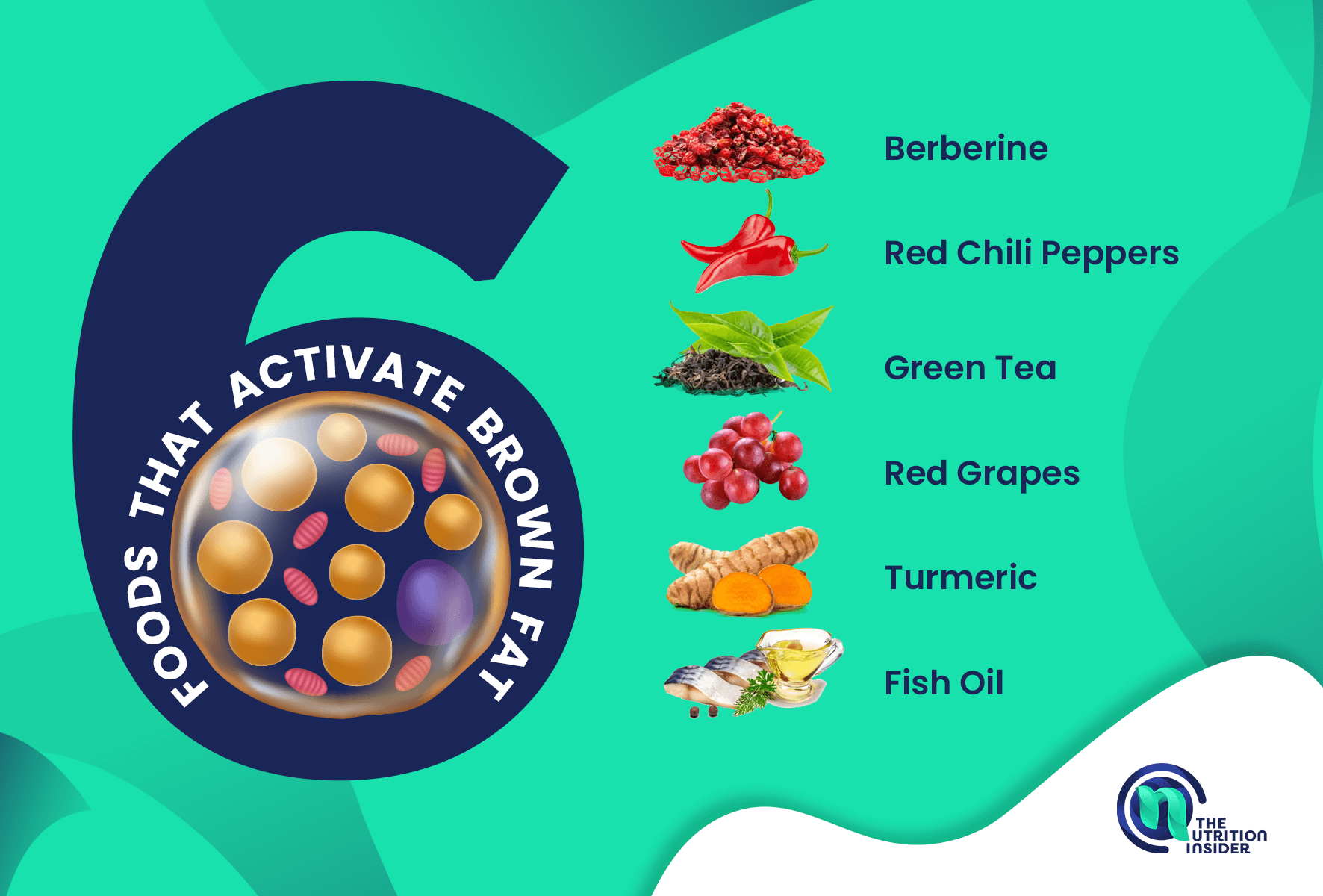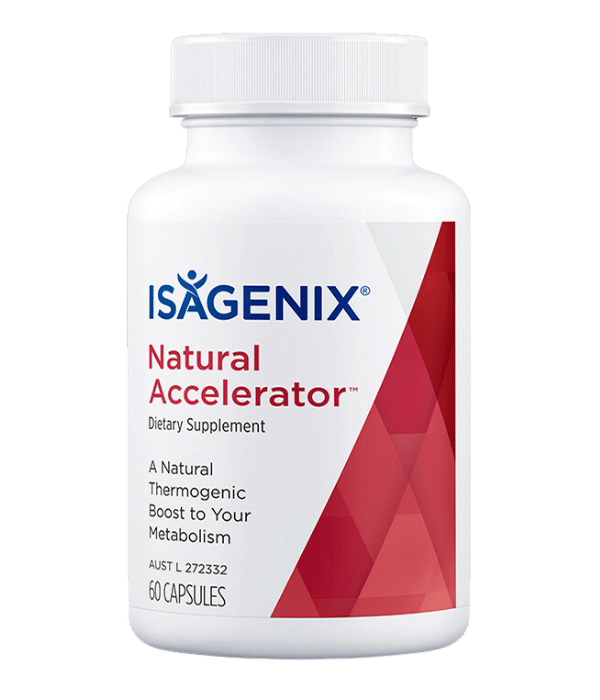Try our favorite, clean protein powder: See our top pick →
Try our favorite, clean protein powder: See our top pick →
Evidence Based Research To fulfill our commitment to bringing our audience accurate and insightful content, our expert writers and medical reviewers rely on carefully curated research.
Read Our Editorial Policy
Despite what many people believe, not all fat in our bodies is undesirable.
In addition to the “bad” kind called white fat that is implicated in obesity and its associated health conditions, we also have a unique type of fat called brown fat.
This beneficial fat—also known as brown adipose tissue (BAT)—burns more calories than typical fat tissue and supports healthy metabolism and body weight.
In this article, learn more about the health benefits of brown fat, how it can be a secret weapon for weight loss, and how to turn white fat into brown fat naturally with food, supplements, spices, and lifestyle changes.
Brown fat is beneficial because it contains higher quantities of iron-rich mitochondria, providing the tissue with its copper-brown color.
The energy-producing mitochondria in brown fat act as little engines that create heat from energy—also known as brown fat thermogenesis.
Researchers once thought that only infants had brown fat because they can’t maintain their body temperature by shivering, so they use their heat-producing brown fat engines to keep them warm instead.
Now, we know that adults carry this healthy fat, too—albeit in smaller amounts, especially in cases of advancing age, poor health, or obesity.
Both babies and adults have brown fat pockets in similar areas, typically stored around the neck and shoulders.
People who have higher amounts of brown fat tend to have healthier body weights, as about 20% of overall energy expenditure—the number of calories your body burns—can be attributed to thermogenesis.
The primary purpose of brown fat is to break down glucose and fat molecules to create heat and maintain body temperature—especially in those non-shivering infants.
But as we grow older, this process of thermogenesis also helps to burn calories, reduce inflammation, and support metabolic health.
Brown fat’s thermogenic qualities work through a mitochondrial protein called uncoupling protein 1 (UCP1), which was originally called thermogenin due to its role in thermogenesis.
UCP1 causes the mitochondria to “uncouple” the respiratory chain from ATP (adenosine triphosphate) production, meaning it will produce heat rather than ATP.
In simplistic terms, brown fat burns calories in the form of energy, while white fat stores energy from calories.
But we do need both types in our bodies, as white fat—or white adipose tissue (WAT)—also plays a role in modulating thermogenic processes.
The breakdown of white fat cells—like when you lose weight—is essential for brown fat cells to activate and function properly because they release free fatty acids that brown fat cells use to create heat.
White fat cells also store calories for future use and release adiponectin and leptin, two hormones that regulate blood sugar metabolism, energy balance, and satiety.
Although it’s clear that brown fat is more beneficial than white fat, this suggests that both colors of fat play a role in maintaining thermogenic regulation.
There is also a third, more recently discovered type of fat, called beige fat.
Also referred to as “brown-like,” “induced brown fat,” or “brite” adipocytes, this type of fat occurs when white fat cells develop the thermogenic effects of brown fat cells.
This “browning” of white fat cells is thought to be highly beneficial, as inducing this transformation increases their mitochondrial activity and can target cardiometabolic conditions like type 2 diabetes, obesity, and heart disease.

Even if you don’t have high brown fat stores now, there are fortunately several ways to transform white fat cells into brown, including foods, spices, supplements, exercise, and cold exposure.
Certain foods and spices stimulate molecular and metabolic pathways that trigger the browning of fat cells.

With over 10 thermogenic powerhouses, Hi-Health’s Metabolic Fusion offers a formulation designed to help with focus, energy, and metabolism in easy-to-take capsules.
Green Tea Extract, Green Coffee Bean Extract, Raspberry Ketone, Olive Leaf Extract, Caffeine Anhydrous Powder, Bacopa Extract, Garcinia Extract, CLA Oil Powder, L-Theanine, Forskolin Root Extract, BioPerine® Black Pepper Extract, Vegetable Capsule (Hydroxypropyl Methylcellulose), and Organic Rice Fiber.
Acute exposure to cold temperatures can increase brown fat activity or promote the browning of white fat.
This is because of brown fat’s thermogenic effects, as cold temperatures activate the adipose tissue to burn energy—this is how brown fat keeps infants warm.
Upon cold exposure, brown fat produces a specific protein that brings amino acids into the mitochondria, where the amino acids are used to generate heat.
The most common way to use cold therapy is by taking cold showers, with the temperature range most often studied being 64-66 degrees Fahrenheit.
Although the most benefit is seen with two hours of cold exposure per day, even shorter amounts can be beneficial—like those ten minutes of shower time.
Moderate exercise stimulates the production of irisin, a hormone that boosts metabolism and is secreted by the muscles in response to physical activity.
Irisin is known to promote thermogenesis and the browning of white fat.
However, moderate exercise is key—over-exercising can have detrimental effects on brown fat activity, especially in women.
Due to the metabolic activity of brown fat, this type of adipose tissue is thought to benefit people with type 2 diabetes or prediabetes.
Brown fat has a higher rate of glucose uptake than other tissues, allowing it to support healthier blood sugar levels.
Research has shown that people with less brown fat are more likely to have insulin resistance—a key determinant of developing type 2 diabetes.
In a study that exposed healthy adults to cold temperatures, brown fat activity was increased, and glucose uptake was improved by 20%.
This research indicates that cold exposure could be highly beneficial for people with type 2 diabetes.
Brown fat’s energy-burning effects also bode well for obese or overweight people.
Obesity tends to be rooted in inflammation, and brown adipose tissue is much less susceptible to developing inflammation than white adipose tissue.
Just as white fat can transform to beige or brown adipose tissue, brown fat can also switch into white fat, a process known as “brown fat whitening” that contributes to obesity.
Plus, many of the comorbidities associated with obesity—like type 2 diabetes and heart disease—are also related to low-grade, chronic inflammation of white fat.
Using full-body scans, studies have found that greater quantities of brown fat are present in people with lower body mass indices (BMI), especially in older adults.
Although we know that brown fat activity increases energy expenditure, the actual amount of calories burned will vary from person to person.
One review estimated that fully stimulated brown adipose tissue could lead to an additional 100 calories per day of energy expended.
While it doesn’t sound like a ton, it could certainly add up over time to support or maintain a healthier weight.
Several nutrients and antioxidants are thought to turn white fat into brown fat, including:
– Curcumin from turmeric
– Resveratrol from red grapes
– EGCG from green tea
– Capsaicin from chili peppers
– Omega-3 fats from fish oil
One form of vitamin A called retinoic acid is also thought to induce the browning of white fat.
Yes, the antioxidant compound resveratrol has been studied for its role in increasing brown fat activity and the transformation of white fat into brown fat.
The spices curcumin and the herb berberine are known to activate brown fat.
The compound capsaicin is also found in some spices, like chili powder, and can induce fat browning.
Lastly, cinnamon has shown some promise as a spice that activates brown fat.
Yes, research suggests that having greater amounts of brown fat activity can help people with type 2 diabetes.
This is because brown fat is metabolically active and promotes glucose uptake into cells, which lowers blood sugar and reduces insulin resistance.
Andrade JM, Frade AC, Guimarães JB, et al. Resveratrol increases brown adipose tissue thermogenesis markers by increasing SIRT1 and energy expenditure, and decreasing fat accumulation in adipose tissue of mice fed a standard diet. Eur J Nutr. 2014;53(7):1503-1510. doi:10.1007/s00394-014-0655-6
Cypess AM, Lehman S, Williams G, et al. Identification and importance of brown adipose tissue in adult humans. N Engl J Med. 2009;360(15):1509-1517. doi:10.1056/NEJMoa0810780
Hursel R, Viechtbauer W, Dulloo AG, et al. The effects of catechin-rich teas and caffeine on energy expenditure and fat oxidation: a meta-analysis. Obes Rev. 2011;12(7):e573-e581. doi:10.1111/j.1467-789X.2011.00862.x
Jung SM, Sanchez-Gurmaches J, Guertin DA. Brown Adipose Tissue Development and Metabolism. Handb Exp Pharmacol. 2019;251:3-36. doi:10.1007/164_2018_168
Koksharova E, Ustyuzhanin D, Philippov Y, et al. The Relationship Between Brown Adipose Tissue Content in Supraclavicular Fat Depots and Insulin Sensitivity in Patients with Type 2 Diabetes Mellitus and Prediabetes. Diabetes Technol Ther. 2017;19(2):96-102. doi:10.1089/dia.2016.0360
Kwan HY, Wu J, Su T, et al. Cinnamon induces browning in subcutaneous adipocytes. Sci Rep. 2017;7(1):2447. Published 2017 May 26. doi:10.1038/s41598-017-02263-5
Marlatt KL, Ravussin E. Brown Adipose Tissue: an Update on Recent Findings. Curr Obes Rep. 2017;6(4):389-396. doi:10.1007/s13679-017-0283-6
Nomura S, Ichinose T, Jinde M, Kawashima Y, Tachiyashiki K, Imaizumi K. Tea catechins enhance the mRNA expression of uncoupling protein 1 in rat brown adipose tissue. J Nutr Biochem. 2008;19(12):840-847. doi:10.1016/j.jnutbio.2007.11.005
Okla M, Kim J, Koehler K, Chung S. Dietary Factors Promoting Brown and Beige Fat Development and Thermogenesis. Adv Nutr. 2017;8(3):473-483. Published 2017 May 15. doi:10.3945/an.116.014332
Oudart H, Groscolas R, Calgari C, et al. Brown fat thermogenesis in rats fed high-fat diets enriched with n-3 polyunsaturated fatty acids. Int J Obes Relat Metab Disord. 1997;21(11):955-962. doi:10.1038/SJ.ijo.0800500
Wang W, Seale P. Control of brown and beige fat development. Nat Rev Mol Cell Biol. 2016;17(11):691-702. doi:10.1038/nrm.2016.96
Wang S, Wang X, Ye Z, et al. Curcumin promotes browning of white adipose tissue in a norepinephrine-dependent way. Biochem Biophys Res Commun. 2015;466(2):247-253. doi:10.1016/j.bbrc.2015.09.018
Subscribe now and never miss anything about the topics important to you and your health.
5 Comments
Is diet green tea good?
These foods look promising. Indians have known the value of turmeric as a helping any kind of hurting to become better. And chilliest especially the green ones as keeping body weight down, same goes for cinnamon.
But thank you for stating about green tea, red grapes, fish oils (usually cod liver oil in capsule form, but is there an alternative for vegetarians). I would like to know the recipe for making brown fats.
Hello, thank you for all the good information!!
I am so trying to lose weight!
I appreciate all the advice and support here!
Have a great day!! 😀❤️
Do your research . Using PUBMED and Dr William Li videos. These are good starting points. God Bless your work on reducing and improving your health.
Thanks for the information I will put it to use